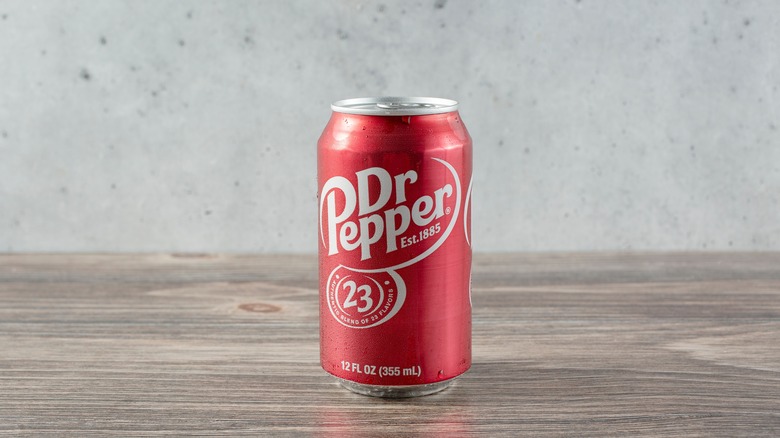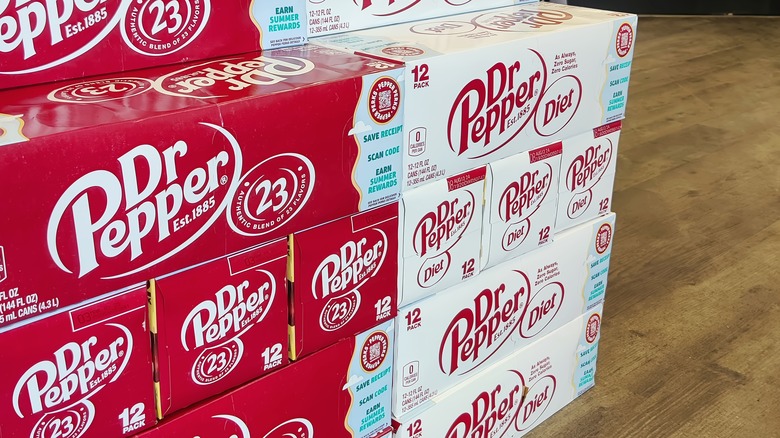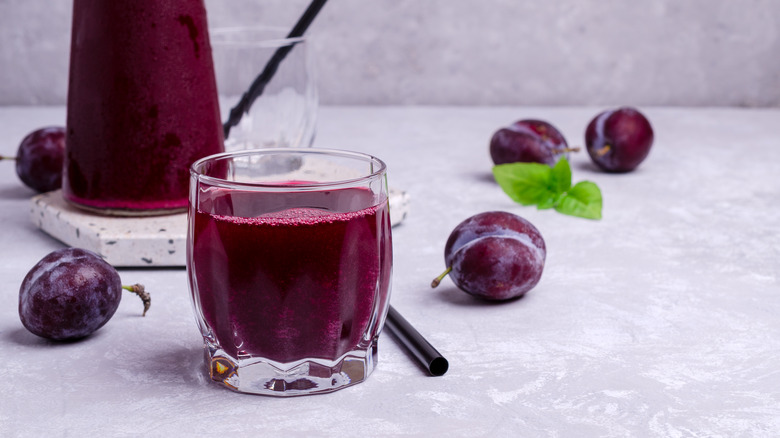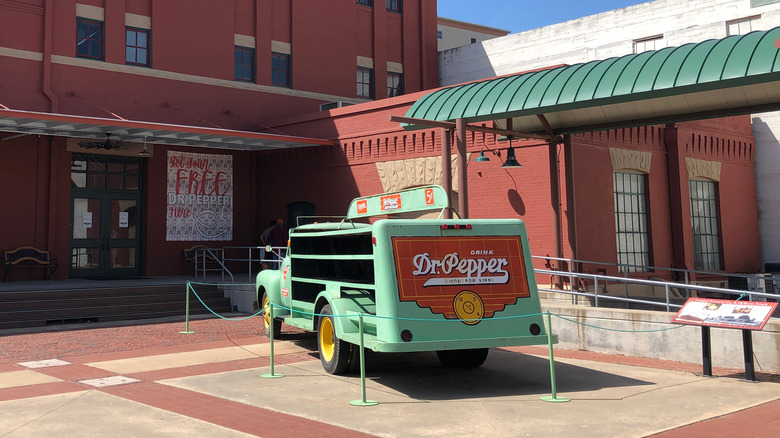Have We Solved The Mystery Of Dr Pepper's 23 Flavors?
From fast food chains to soda brands, plenty of companies purposely keep their recipes a secret — or, at least, try to. In 2016, the nephew of KFC's Colonel Sanders, founder of KFC, accidentally leaked the combination of 11 herbs and spices used to coat the chain's famous fried chicken. Culinary sleuths have thoroughly compared secret sauces from Raising Cane's and Chick-fil-A to create copycat versions. Even former Starbucks baristas have taken to social media to share instructions for preparing popular drinks at home. But while the beans have been spilled on some famous foods and drinks shrouded in secrecy, many others — including Dr Pepper's proprietary recipe — are still open to speculation.
Fans of Dr Pepper, the second biggest soda brand in the United States behind Coca-Cola, per Beverage Digest, know that it isn't quite like any other popular soda. Instead, it's more like all of them mixed together. While you know exactly what you're tasting when you sip on tangy orange Fanta or gingery Canada Dry, Dr Pepper's one-of-a-kind taste is the product of nearly two dozen flavors. Central to the brand's marketing, this fact is proudly displayed on the soda's packaging with the tagline, "Authentic blend of 23 flavors." However, the company has kept a tight lid on what those flavors are. That hasn't stopped people from trying to solve the mystery, though. While it hasn't been officially confirmed (and may never be), the masses have put forth guesses of the flavors that make Dr Pepper so uniquely tasty.
The speculation surrounding Dr Pepper's many flavors
You probably won't be able to put together a list of 23 flavors by simply sipping on Dr Pepper. The soda isn't a standard cola, by any means; in fact, the FDA ruled that it specifically wasn't one in 1966. Instead, the soft drink is sometimes referred to as a "pepper soda," reflecting its sweet but slightly spicy taste, which, pairs surprisingly well with pickles. Some people detect strong notes of cherry, citrus, and vanilla, but that only covers a few bases. The soda's ingredients list isn't much help either, lumping them together under a natural and artificial flavors catch-all.
Still, there are specific guesses at what the 23 flavors could be. One Reddit post from 2024 suggested an assortment of fruits, spices, and botanicals, including allspice, almond, caramel, ginger, orange, plum, sarsaparilla, and vanilla. Another list shared on Reddit in the early 2010s named a few other possible flavors like carrot, prune, raspberry, root beer, rum, and tomato.
Many of these flavors seem sensible and some are true to the 1880s when the soda was created. Sarsaparilla, for instance, tastes similar to root beer and was one of the first soft drink flavorings in the 19th century. Others may be unfamiliar or surprising — carrot and tomato, really? Of course, the company hasn't confirmed any of these guesses. However, they have openly denied at least one.
The flavor that the company has outright denied
While lists of Dr Pepper's 23 flavors have been circulating online for years, fans of the famous soda have been speculating since before the World Wide Web existed. And the company hasn't always stayed quiet about whether or not any guesses were accurate. One of the oldest rumored ingredients — prune juice — is confirmed to not be part of Dr Pepper's proprietary recipe.
A Texas Monthly article published in 1973 addressed a long-time belief that the soft drink contained prunes for potential digestive benefits. While Olipop might be the modern "healthy" soda, Dr Pepper, Coca-Cola, and many other sodas were marketed as healthful and therapeutic in the late 19th and early 20th centuries — a strategy stemming from a long history of medicinal tonics. Advertising Dr Pepper as a cure for ailments had fallen out of fashion by the 1970s, though. Per Texas Monthly, W. W. Clements, who went from selling Dr Pepper on a college campus to presiding over the company, also denied the alleged presence of prunes in the drink.
Clearly, the prune rumor didn't go away entirely, as it still made potential flavor lists decades later. But as of 2011, Keurig Dr Pepper's website notes that while the soda features a blend of fruit and flavor extracts, prune juice is not (and never has been) an ingredient in Dr Pepper. Why prunes, in particular, have earned such explicit denial isn't explained, but people have hazarded guesses about this, too (the dried fruit's cultural perception seems to be the culprit).
The story behind Dr Pepper's 23 flavors
Considering the prune debacle, you might wonder why there's so much secrecy surrounding Dr Pepper's 23 flavors. Not to mention, how did a soda made in 1885 — a year before Coca-Cola hit the market — even end up with such a complicated recipe in the first place? The peculiarity of the situation is partly why the company probably won't ever satisfy its customers' curiosity. After all, the mystery makes for good marketing.
The invention of Dr Pepper is often attributed to Charles Alderton, who worked as a pharmacist at Morrison's Old Corner Drug Store in Waco, Texas. According to the Dr Pepper Museum, when he wasn't distributing medicine, he spent his days serving drinks from the soda fountain, which would create a distinct aroma of all the various fruit syrups mixed together. In an attempt to create a drink that tasted like the store smelled, he started experimenting with different combinations of soda syrups until he eventually settled on the blend used for Dr Pepper.
By the 1970s, advertisements for the soda started focusing on its unique taste. The famous "Be a Pepper" campaign portrayed a fun and exciting individuality that its customers should internalize, figuratively and literally. And though there's no confirmation on what exactly Dr Pepper's 23 flavors are, you can always fall back on the fan-made lists and its history to describe it. The one-of-a-kind soda manages to taste wholly original.



